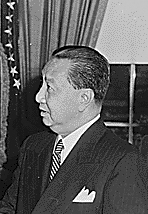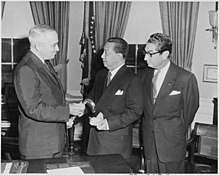Elpidio Quirino
Elpidio Rivera Quirino (born November 16, 1890 in Vigan , Ilocos Sur Province , Philippines , † February 29, 1956 in Novaliches ) was a Filipino politician and President of the Philippines .
Studies and early political activities
After completing his law studies at the University of the Philippines in 1915, he worked for the next four years, first as a lawyer and later as a teacher in a barangay in his native Vigan. This was followed by a brief employment in the real estate office and as an office manager in the Manila Police Department .
Soon afterwards he came into contact with politics for the first time by becoming the private secretary of the then Senate President Manuel Quezon .
MP, Senator and Minister
Quirino began his political career in 1919 when he was elected to the House of Representatives of the Philippine legislature for the province of Ilocos Sur .
Quirino was first elected Senator in 1925 and re-elected in 1931. As such, he accompanied the then Senator and later President Sergio Osmeña on the delegation trip to the USA in 1933 for the negotiations on the independence of the Philippines. The Tydings-McDuffie Act negotiated there in 1934 finally paved the way for the Commonwealth of the Philippines and later independence. Subsequently, he was a participant in the commission for drafting a constitution .
With the subsequent establishment of the Philippine Commonwealth on November 15, 1935, he was appointed Minister of Finance by President Quezon. He held this office until 1936. At the same time he was Minister of the Interior from 1935 to 1938.
Japanese occupation and Republic of the Philippines
From 1941 to 1946 he was re-elected senator. During the occupation of the Philippines by Japan , he led a rebel movement against the Japanese occupation forces . As such, however, he was captured and imprisoned by Japanese troops . His wife and their three children were murdered by Japanese soldiers.
After the liberation of the Philippines by the US Army under General Douglas MacArthur from February 1945, he resumed his office as Senator. From August 17, 1945 to May 28, 1946 he was President of the Senate Pro Tempore , the Commonwealth Congress .
In the first presidential election in the spring of 1946, Quirino was elected vice president. The then elected President Manuel Roxas also appointed him Foreign Minister. Before that, the liberal wing of the "Nacionalista Party" split off from the party and formed two separate groups: the liberal wing around Roxas and Quirino and the liberal wing around the then Senate President José Avelino .
President of the Republic of the Philippines
Term of office 1948 to 1953
When President Roxas died on April 15, 1948, Vice President Quirino was made president the next day by virtue of the constitution. In the 1949 presidential election he was re-elected president with 51 percent after defeating the candidate of the “Nacionalista Party”, the former president during the Japanese occupation, José P. Laurel .
During his presidency he endeavored to rebuild the Philippines, a general improvement in economic income and an increase in American financial aid. On the other hand, the problems of rural areas and social security often remained unsolved.
Furthermore, during the years of his term of office there were repeated armed conflicts with the communist rebel organization Hukbalahap , which emerged from the anti-Japanese resistance movement , which could not be settled until 1954 under his successor.
During his reign, the administration was often characterized by bribery and nepotism, although in the 1949 election campaign he had campaigned for more people to trust the government. The allegations of corruption and bribery against Quirino and his government finally culminated in the first impeachment proceedings against a Philippine president.
Despite these controversies, at least the successes of his government in industrial projects, an expansion of irrigation, the expansion of the road system, the establishment of the central bank and local banking companies and, last but not least, the peace made with the former occupying power of Japan, remained in positive memories.
Presidential nomination in 1953 and defeat
Quirino ran again in 1953 despite illness as a candidate of a now united "Liberal Party" for president. In the election he was defeated by the candidate of the "Nacionalista Party", Ramon Magsaysay with an election result of 68.9 percent for Magsaysay and 31.0 percent for Quirino.
Elpidio Quirino then withdrew from politics and died on February 29, 1956. His death is commemorated on February 28.
swell
- Information in rulers.org
- Biography in geocities.com ( Memento from January 6, 2008 in the Internet Archive )
- Biography in globalpinoy.com
Web links
- Newspaper article about Elpidio Quirino in the press kit of the 20th century of the ZBW - Leibniz Information Center for Economics .
| personal data | |
|---|---|
| SURNAME | Quirino, Elpidio |
| ALTERNATIVE NAMES | Quirino, Elpidio Rivera |
| BRIEF DESCRIPTION | Philippine President |
| DATE OF BIRTH | November 16, 1890 |
| PLACE OF BIRTH | Vigan , Ilocos Sur |
| DATE OF DEATH | February 29, 1956 |
| Place of death | Novaliches |

